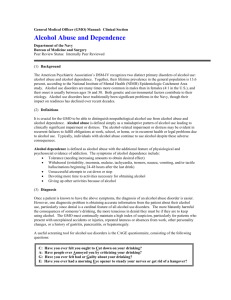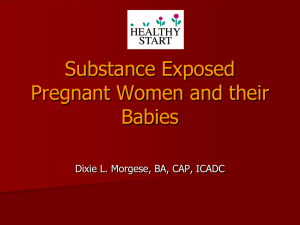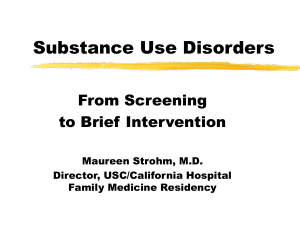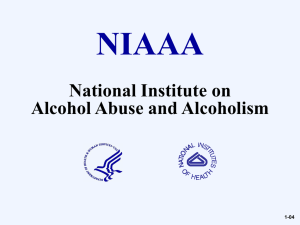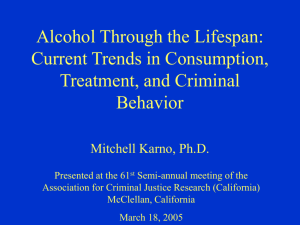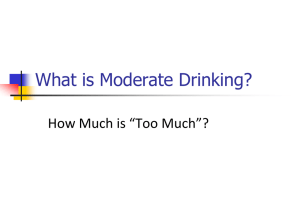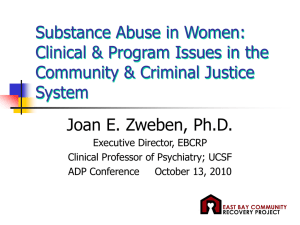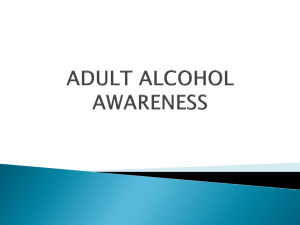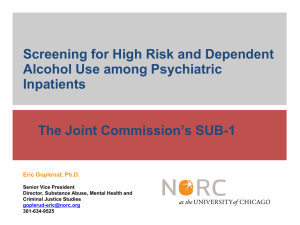Substance Abuse Assessments
advertisement
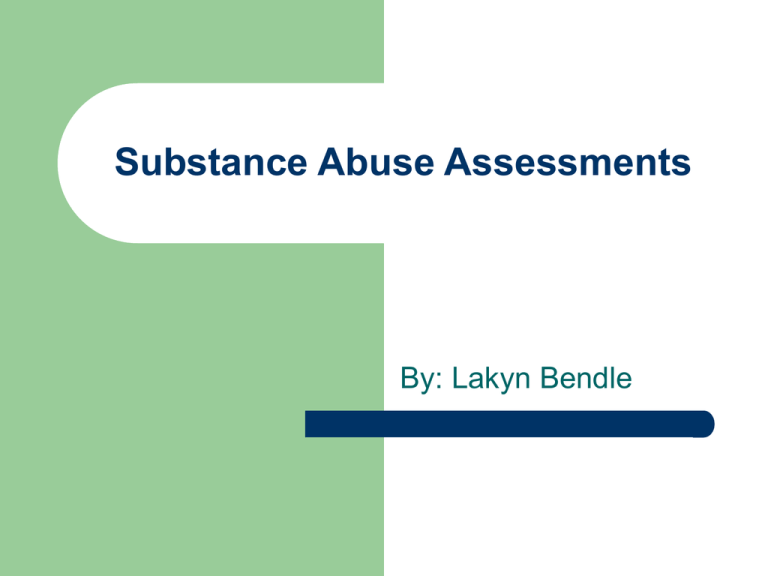
Substance Abuse Assessments By: Lakyn Bendle Did you know? In United States of America, the root cause for 25% of the total deaths can be attributed to drug or alcohol abuse 65% of addicts get access from their family and friends Drug or alcohol withdraw can bring in hallucinations, paranoia, seizures or even be proven fatal Medication cost of a drug or alcohol addict is almost 2 times the medication cost for a clean individual Drug abuse is the most common problem among food service and construction workers 75% of domestic violence is caused by people with addictions A drink is… One small 8 ounce or ½ pint of beer One single shot of liquor One glass of wine Who and where do you assess? Medical patients/primary care clinics Accident victims/emergency room Psychiatric patients/hospitals DWI offenders and violent criminals/prison People with impaired social or occupational functioning/mental health facilities Enlisted men and officers/military services Workers/employee assistants programs Self Report or Interview? Self report allows for analysis of measure Could use alcohol or drug measures among other types of measures to keep defensiveness down Interviewing is less suspicious and you may get more information from verbal responses The C.A.G.E. Dr. John Ewing, founding director of the Bowles Center for Alcohol Studies, University of North Carolina at Chapel Hill developed the CAGE for identifying alcohol related problems. C Have you ever felt you ought to CUT down on your drinking? A Have people ANNOYED you by criticizing your drinking? G Have you ever felt bad or GUILTY about your drinking? E Have you ever had a drink first thing in the morning (EYE OPENER) to steady your nerves or get rid of a hangover? The C.A.G.E. (cont.) Screening test for alcohol abuse Two positive responses are considered a positive test and indicate further assessment is warranted Most widely used in emergency department (ED) settings High test-retest reliability (0.80-0.95), and adequate correlations (0.480.70) with other screening instruments and the DSM-III for alcohol dependence Advantage = denial Disadvantage = most accurate for white middle aged men The T-ACE The T-ACE was originally designed by an obstetrician from the CAGE to screen for pregnancy risk drinking. T Tolerance: How many drinks does it take to make you feel high? A Have you ever been annoyed by people's criticism of your drinking? C Have you ever felt you ought to cut down on your drinking? E Eye opener: Have you ever had a drink first thing in the morning to steady your nerves or get rid of a hangover? The T-ACE Identifies women’s prenatal alcohol consumption and pregnancy risk drinking (defined as more than two drinks per drinking day) Affirmative answers to questions A, C, or E = 1 point each. Reporting tolerance to more than two drinks (the T question) = 2 points A score of 2 or more is considered positive Recent studies have found it accurate for men (3 drinks) and women now More superior to the CAGE The Drug Abuse Screening Test (DAST) Includes 28 true/false questions Questions refer to the last 12 months and does not include alcohol Includes non-medical use of drugs and use of prescribed or “over the counter” drugs in excess of directions 85 percent overall accuracy in classifying clients according to DSM-III diagnosis Michigan Alcoholism Screening Test (MAST) The MAST is a 22 item true/false test which asks specific questions about alcohol use and its impact on life situations The MAST is particularly useful for identifying alcohol dependence Most widely used measure Correlates with the AUDIT and CAGE Advantage = lifetime use Disadvantage = vague Alcohol Use Disorders Identification Test (AUDIT) Includes questions about the quantity and frequency of alcohol use, as well as binge drinking, dependence symptoms, and alcohol related problems. Its strength lies in its ability to identify people who have problems with alcohol but who may not be dependent. Especially useful when screening women and minorities. Promising results when tested in adolescents and young adults Less accurate in older patients The AUDIT (cont.) A score of 8 or more in men (7 in women) indicates a strong likelihood of hazardous or harmful alcohol consumption. A score of 15 or more in men (13 in women) is suggestive of alcohol dependence Advantage = addresses alcohol abuse, dependence, and consequences Disadvantage = easier to see extremes SADRI Substance Abuse Symptoms Checklist Several or more of these symptoms in combination may suggest that issues related to substance abuse should be explored at greater length. 1) 2) 3) 4) 5) 6) 7) Frequent Intoxication Atypical Social Settings Intentional Heavy Use Symptomatic Drinking Psychological Dependence Health Problems Job Problems 8) 9) 10) 11) 12) 13) Problems With Significant Others Problems With Law Or Authority Financial Problems Belligerence Isolation “Handicapism” Resources http://www.nida.nih.gov/nidahome.html http://www.samhsa.gov/ http://www.daodas.state.sc.us/ Substance Abuse, Disability and Vocational Rehabilitation Handbook
